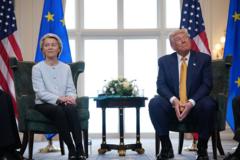The unfolding dynamics of the EU-US trade agreement, recently brokered by European Commission chief Ursula von der Leyen and US President Donald Trump, reveal significant dissatisfaction among European stakeholders regarding the specifics and impact of the arrangement. Announced amidst a backdrop of rising tensions and dire warnings of potential 30% tariffs, the final agreement stipulates a 15% tariff on most EU exports to the US, a considerable rise from the previous average of 4.8%.
Initially met with relief by some in Europe, the announcement has since given rise to scrutiny of von der Leyen and the approach taken during negotiations. Many European leaders expressed regret over what they consider a "soft stance" and have voiced the need for a more assertive position moving forward. For instance, Germany’s finance minister Lars Klingbeil noted the deal’s role in providing stability, yet lamented a different outcome could have been more favorable.
As conversations continue, it is important to understand that the agreement remains non-binding; the European Commission described it as a “set of political commitments.” Without a formal joint statement, there are still critical discussions pending over tariffs on vital sectors such as pharmaceuticals and semiconductors. The US claims these industries will fall under the new rates, yet the EU maintains that their current 0% tariffs will persist until negotiated terms are fully established and clarified.
French President Emmanuel Macron reiterated that this agreement represents merely a first step, calling for ongoing negotiations to address these inconsistencies and ensuring Europe is firm in its dealings. Analysts like Cinzia Alcidi from the Centre for European Policy Studies emphasize that while the blanket tariff may grant immediate predictability for industries, the long-term framework will require extensive negotiation.
Diverging interpretations of purchase commitments further complicate the situation. The US asserts that the EU will commit to substantial purchases in energy resources, while the EU only suggests its intentions to do so. Additionally, the lack of detail on military equipment spending raises concerns among EU members, as previous investments are predominantly funneled to the US defense sector.
As countries begin to assess the ramifications, it is clear that the deal’s effects will not be evenly distributed across Europe. Notably, Germany and Ireland are uniquely vulnerable due to their substantial exports to the US, particularly in automotive and pharmaceutical sectors. Italy is similarly affected, with some economic analysts predicting a 0.2% GDP hit. Discontent among trade representatives in Italy has emerged, with claims of feeling “surrendered” rather than engaged in an equitable negotiation.
Ultimately, the quarterly landscape of US-EU negotiations, while offering short-term expectations of stability, highlights the need for European negotiators to adopt a unified, robust approach to safeguarding their economic interests, especially in light of potential tariffs that could ultimately burden taxpayers. As these discussions unfold, the push for clarity, coherence, and fairness in the underlying agreements will be paramount.




















